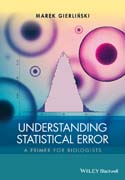
This accessible introductory textbook provides a straightforward, practical explanation of how statistical analysis and error measurements should be applied in biological research. Understanding Statistical Error – A Primer for Biologists: Introduces the essential topic of error analysis to biologists Contains mathematics at a level that all biologists can grasp Presents the formulas required to calculate each confidence interval for use in practice Is based on a successful series of lectures from the author s established course Assuming no prior knowledge of statistics, this book covers the central topics needed for efficient data analysis, ranging from probability distributions, statistical estimators, confidence intervals, error propagation and uncertainties in linear regression, to advice on how to use error bars in graphs properly. Using simple mathematics, all these topics are carefully explained and illustrated with figures and worked examples. The emphasis throughout is on visual representation and on helping the reader to approach the analysis of experimental data with confidence. This useful guide explains how to evaluate uncertainties of key parameters, such as the mean, median, proportion and correlation coefficient. Crucially, the reader will also learn why confidence intervals are important and how they compare against other measures of uncertainty. Understanding Statistical Error – A Primer for Biologists can be used both by students and researchers to deepen their knowledge and find practical formulae to carry out error analysis calculations. It is a valuable guide for students, experimental biologists and professional researchers in biology, biostatistics, computational biology, cell and molecular biology, ecology, biological chemistry, drug discovery, biophysics, as well as wider subjects within life sciences and any field where error analysis is required. INDICE: Introduction 3 .Why would you read an introduction? 3 .What is this book about? 3 .Who is this book for? 4 .About maths 4 .Acknowledgements 4 .Chapter 1 Why do we need to evaluate errors? 9 .Chapter 2 Probability distributions 11 .2.1 Random variables 11 .2.2 What is a probability distribution? 13 .Probability distribution of a discrete variable 13 .Probability distribution of a continuous variable 13 .Cumulative probability distribution 14 .2.3 Mean, median, variance and standard deviation 15 .2.4 Gaussian distribution 16 .Example: estimate an outlier 17 .2.5 Central limit theorem 18 .2.6 Log–normal distribution 20 .2.7 Binomial distribution 21 .2.8 Poisson distribution 24 .Classic example: horse kicks 26 .Interarrival times 27 .2.9 Student s t–distribution 28 .2.10 Exercises 29 .Chapter 3 Measurement errors 31 .3.1 Where do errors come from? 31 .Systematic errors 32 .Random errors 33 .3.2 Simple model of random measurement errors 33 .3.3 Intrinsic variability 35 .3.4 Sampling error 36 .Sampling in time 37 .3.5 Simple measurement errors 38 .Reading error 38 .Counting error 40 .3.6 Exercises 42 .Chapter 4 Statistical estimators 43 .4.1 Population and sample 43 .4.2 What is a statistical estimator? 45 .4.3 Estimator bias 47 .4.4 Commonly used statistical estimators 47 .Mean 47 .Weighted mean 48 .Geometric mean 49 .Median 50 .Standard deviation 51 .Unbiased estimator of standard deviation 52 .Mean deviation 55 .Pearson s correlation coefficient 55 .Proportion 57 .4.5 Standard error 58 .4.6 Standard error of the weighted mean 61 .4.7 Error in the error 62 .4.8 Degrees of freedom 63 .4.9 Exercises 63 .Chapter 5 Confidence intervals 65 .5.1 Sampling distribution 66 .5.2 Confidence interval: what does it really mean? 68 .5.3 Why 95%? 69 .5.4 Confidence interval of the mean 70 .Example 73 .5.5 Standard error vs. confidence interval 73 .How many standard errors are in a confidence interval? 73 .What is the confidence of the standard error? 74 .5.6 Confidence interval of the median 75 .Simple approximation 77 .Example 78 .5.7 Confidence interval of the correlation coefficient 78 .Significance of correlation 81 .5.8 Confidence interval of a proportion 82 .5.9 Confidence interval for count data 86 .Simple approximation 88 .Errors on count data are not integers 88 .5.10 Bootstrapping 89 .5.11 Replicates 90 .Sample size to find the mean 92 .5.12 Exercises 93 .Chapter 6 Error bars 97 .6.1 Designing a good plot 97 .Elements of a good plot 98 .Lines in plots 99 .A digression on plot labels 100 .Logarithmic plots 101 .6.2 Error bars in plots 102 .Various types of errors 103 .How to draw error bars 103 .Box plots 104 .Bar plots 105 .Pie charts 109 .Overlapping error bars 109 .6.3 When can you get away without error bars? 111 .On a categorical variable 111 .When presenting raw data 111 .Large groups of data points 111 .Where errors are small and negligible 111 .Where errors are not known 112 .6.4 Quoting numbers and errors 112 .Significant figures 112 .Writing significant figures 113 .Errors and significant figures 114 .Error with no error 115 .Computer generated numbers 117 .Summary 118 .6.5 Exercises 118 .Chapter 7 Propagation of errors 121 .7.1 What is propagation of errors? 121 .7.2 Single variable 122 .Scaling 123 .Logarithm 123 .7.3 Multiple variables 124 .Sum or difference 125 .Ratio or product 126 .7.4 Correlated variables 127 .7.5 To use error propagation or not? 127 .7.6 Example: distance between two dots 129 .7.7 Derivation of the error propagation formula for one variable 130 .7.8 Derivation of the error propagation formula for multiple variables 131 .7.9 Exercises 133 .Chapter 8 Errors in simple linear regression 135 .8.1 Linear relation between two variables 135 .Mean response 136 .True response and noise 137 .Data linearization 137 .8.2 Straight line fit 138 .8.3 Confidence intervals of linear fit parameters 140 .Example 144 .8.4 Linear fit prediction errors 145 .8.5 Regression through the origin 147 .Example 149 .8.6 General curve fitting 150 .8.7 Derivation of errors on fit parameters 152 .8.8 Exercises 153 .Chapter 9 Worked example 155 .9.1 The experiment 155 .9.2 Results 156 .Sasha 157 .Lyosha 159 .Masha 161 .9.3 Discussion 162 .9.4 The final paragraph 164 .Solutions to exercises 165 .Bibliography 178 .Index 179
- ISBN: 978-1-119-10691-3
- Editorial: Wiley–Blackwell
- Encuadernacion: Rústica
- Páginas: 216
- Fecha Publicación: 29/01/2016
- Nº Volúmenes: 1
- Idioma: Inglés
